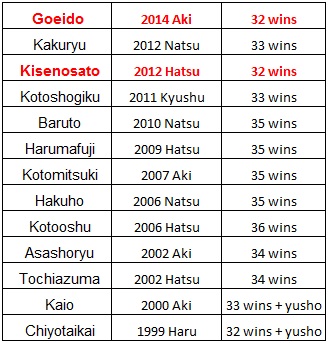
Home | User Forum | News | Fantasy Sumo | Media Requests | Contributors | About Us | Sumo 101 | Links | Archives | Swedish
2014 Nagoya Post-basho Report
 As
I got up the Monday morning after the basho and scanned the headlines and
pictures from the wires, 75% of the attention was placed on Goeido and his
securing promotion to Ozeki. Nearly 25% was devoted to Hakuho and his
accomplishment of reaching the 30 career yusho mark, and then there was a single
story each on Harumafuji and Kotoshogiku. Since the Japanese media considered
Goeido and his promotion to Ozeki the biggest story coming out of Nagoya, let's
start there and talk about promotion to Ozeki in general.
As
I got up the Monday morning after the basho and scanned the headlines and
pictures from the wires, 75% of the attention was placed on Goeido and his
securing promotion to Ozeki. Nearly 25% was devoted to Hakuho and his
accomplishment of reaching the 30 career yusho mark, and then there was a single
story each on Harumafuji and Kotoshogiku. Since the Japanese media considered
Goeido and his promotion to Ozeki the biggest story coming out of Nagoya, let's
start there and talk about promotion to Ozeki in general.
When someone begins taking interest in sumo, one of the first facts they learn
is that in order to be promoted to Ozeki, a rikishi should garner 33 wins over
three consecutive basho. From the beginning, the number 33 has been an unwritten
rule and mostly acts as a guideline when making the decision to promote or to
wait. If we go back and look at Ozeki promotions from the last 15 years, it
looks like this:

During that time frame, there were also two rikishi who actually surpassed the
33 win mark yet were denied promotion. Those two cases are as follows:
Miyabiyama : 2006 Aki : 34 wins
Kotomitsuki : 2002 Haru : 34 wins + yusho
If we compare the two cases highlighted in red above where rikishi failed to hit
the 33 win mark with the two cases where rikishi who surpassed the 33 win mark
were denied, we notice that all four cases involve Japanese rikishi. And
regardless of the reasons for acceptance/denial in the four cases, we can
clearly state that consideration for promotion to Ozeki regarding those four was
completely subjective. So my question to the readers is: subjective to what?
Why would Kisenosato and Goeido be granted Ozeki status for a lesser achievement
while Kotomitsuki and Miyabiyama were denied for a greater achievement?
I suppose there is not a single answer to that question, but it mostly has to do
with balance on the banzuke. For the 2002 Haru basho (when Kotomitsuki was
denied), there were four Ozeki already on the charts--all of them Japanese, and
then there were two Yokozuna, one a foreigner and one a Japanese rikishi meaning
that 83% of the elite ranks were occupied by Japanese rikishi. I suppose they
denied Kotomitsuki because he was still relatively young, his yusho basho came
from the M2 rank and not the sanyaku, and they felt that there wasn't a need for
another Ozeki.
For the 2006 Aki basho when Miyabiyama was denied, there were five Ozeki (three
Japanese rikishi vs. two foreigners) and one Yokozuna, Asashoryu. The balance of
elite rikishi had now shifted to 50% Japanese rikishi - 50% foreign rikishi, and
by the mid-aughties, the power shift in favor of the foreign rikishi was already
evident. My guess as to why the Association denied Miyabiyama at this time was
because he was in the twilight of his career, and it was evident that
Kotomitsuki (ranked Sekiwake at the time) was showing sure signs of becoming the
next Ozeki anyway.
If you fast forward to the 2011 Nagoya basho, the power had completely shifted
among the elite ranks to where foreign rikishi now occupied 83% of the
Yokozuna/Ozeki ranks with lonely Kaio on two bad wheels comprising the last
bastion of Japanese rikishi with honor on the banzuke. Kaio had been getting
serious help the previous basho (that's plural) just to kachi-koshi, but by the
time Nagoya rolled around, he was clearly done retiring after a 3-8 start. That
meant that for the 2011 Aki basho, the sweep was complete as 100% of the elite
ranks were occupied by foreign rikishi.
The Association could see the decline of Kaio coming early on in 2011, and
that's when Takanohana started touting the next generation of Kisenosato and
Kotoshogiku as Ozeki candidates before those two yayhoos had even done anything.
Fortunately, by the time we finished the Aki basho of that year, Kotoshogiku had
scraped together 33 wins over the last three basho (including two gifts from
Hakuho during that stretch), and he was promoted to Ozeki for the 2011 Kyushu
basho. Kisenosato was one basho behind, and even though he only had 32 wins over
three basho without a yusho, they promoted him anyway to increase the percentage
of Japanese rikishi who occupied the elite ranks of the banzuke.
After Kisenosato's promotion, the attention next shifted immediately to Goeido
who was fortunately going home to Osaka for the 2012 Haru basho where he went?
You guessed it, 12-3!! Goeido was unable to sustain that momentum, however, and
sputtered for the next two years while the Japanese media continued to buoy him
up and tout him as the next Ozeki candidate. Finally, at the 2014 Haru basho,
Goeido regained his former glory by finishing 12-3 again, but as he demonstrated
the two previous years, he was unable to ride that momentum starting out at the
2014 Natsu basho 4-4 and needing serious help down the stretch including an
absolute gift from Hakuho to finish 8-7.
Many readers wondered what the sense of Hakuho's losing to Goeido was at the
Natsu basho, and some just won't believe that yaocho is taking place if it
doesn't result in the yusho for the rikishi receiving the benefit, but it's
worth repeating my take on the importance of the Hakuho - Goeido matchup in
Natsu because the scenario that I described in my Natsu post-basho report was
the exact scenario that played out in Nagoya:
That win over Hakuho was huge
politically because if he loses that bout, he suffers make-koshi, and many on
the surface would say, "Okay, he can easily recover in Nagoya," and while that's
true, it would have completely negated his 12-3 jun-yusho performance in Osaka
in March. I know, we're all thinking, "He went 12-3 in March?" The reason you
don't remember is because it was along the lines of Kisenosato's 13-2 this
basho, but the point is...securing kachi-koshi here in May means he now has 20
wins the last two basho.
Kisenosato was promoted to Ozeki with just 32 wins, so all Goeido needs now is
12 wins again in Nagoya to be worthy of promotion, and it wouldn't surprise me
if they seriously considered him at just 11-4. It's a stretch, I know, but he's
still in the conversation (i.e. headlines) at this point. If he goes 7-8, his
results in Osaka are all for naught, so now you can see just how big that gift
from Hakuho was.
With the coming 2014 Aki basho, the balance among the elite ranks between
foreigners and Japanese rikishi has now been restored to 50-50. Unfortunately,
it's obvious that a shift back towards the Japanese rikishi dominating is NOT
occurring, so how do you go from 100% domination among the elite ranks in favor
of foreign rikishi to a 50-50 clip in the span of a few years? You already know
my take on that question if you've read my reports the last three years, so I
won't rehash it here, but I would ask anyone who considers themselves
knowledgeable about sumo to formulate their own answer to my question. And while
you're at it, think to yourself about the answer to a question I posed in my day
9 comments where I presented numbers shown on NHK that compare Hakuho to the two
rikishi he's chasing down for the all-time yusho lead in Taiho and Chiyonofuji.
The numbers alone produced by NHK show that Hakuho is far and away superior than
those two rikishi, but is that really the case? I already gave my explanation
for the numbers in my day 9 report, but the underlying question I have is how
can one watch sumo and view such numbers and such trends and not critically
think about the reasons behind them?